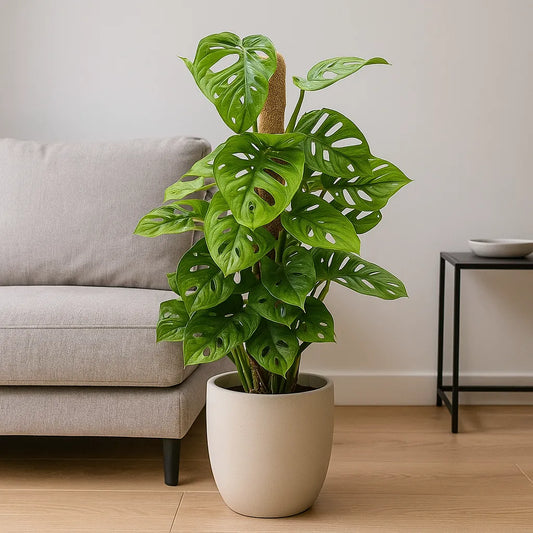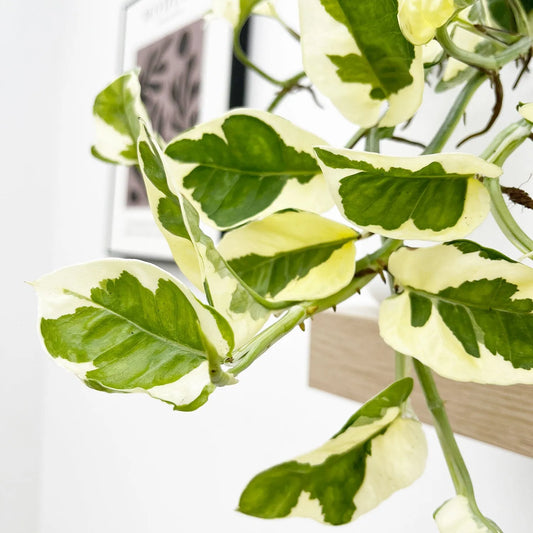Repotting Calathea: A Guide
Calathea plants are a beautiful addition to your houseplant collection, but they are a sensitive plant that is very reactive to its environment. Like all houseplants, your Calathea will eventually need repotting and you need to make sure it is done carefully. In this guide we will take you through when, how and what to do after you repot your Calathea.
When to repot a Calathea plant
As your Calathea grows, the root system will expand and eventually crowd the pot so much that no water or oxygen can move through the soil. This is called being rootbound and will happen every one and a half to two years.
A rootbound Calathea will stop growing and the foliage will begin to wilt and turn yellow. These are all the signs you need to know that your Calathea needs repotting at the next possible opportunity. You should only repot a Calathea in the early spring when the plant is still dormant but about to become active. By doing this you can limit the stress you put your plant through and allow it to produce new roots quickly as it enters the growing season.
How to repot a Calathea houseplant
Repotting a Calathea can be a tricky and delicate task, but if you follow these instructions carefully you can get it down to a fine art and give yourself a fantastic looking houseplant that is thriving and healthy.
What equipment will you need?
The key to successfully repotting your Calathea is speed: the faster you move your plant from one pot to another the less shock and stress it will experience. As part of this it is a good idea to have all the equipment you need ready to go before you start so you don’t have to keep starting and stopping. Here is a list of everything you will need.
A flat surface - when repotting any plant is best to do it on a stable flat surface like a table or potting bench. Repotting can be messy so this helps you keep your space clean and tidy.
Your new pot - make sure you have your new pot on hand and ready to go. When you repot your Calathea make sure your new pot is between one and two inches wider than your current one. Any larger pot will cause you problems when watering your plant and a pot that is too small will just mean you will be repotting your plant again sooner. If you need to drill drainage holes into your pot then make sure you do this before you start repotting.
Trowel - this will help you move the soil and handle your plant, alternatively you can use your hands.
Soil - a suitable potting mix for a Calathea is well-draining, but retains some moisture. A general all-purpose potting mix should be fine, but adding a small amount of perlite to the mixture is a good way to get it perfect. When you move your plant to the new pot make sure you reuse some of the old soil to help your plant adjust to the change. Take a look at our Calathea and Maranta potting mix.
Sharp scissors - these will be used on case you need to remove any leaves or roots
Step by step guide
Step one: Water your plant well the night before you repot it. This will help loosen the soil and reduce the stress of the move.
Step two: Fill the first third of the new pot with soil, leaving a small mound in the middle.
Step three: Loosen the soil around the edges of your plant pot. If any roots are poking through the drainage holes, loosen the soil around them so you can more easily remove the plant. If your Calathea is in a plastic pot, squeeze the sides of it to break the soil up.
Step four: Carefully remove the plant from the pot. Try not to do this by pulling on the stems as this can damage them. A good way to do this is to turn the pot upside down, placing one hand on the soil to support the plant and slowly remove the pot from the plant. If the plant is too large for this you should remove the plant in a way that is easy for you.
Step five: Once the plant is removed inspect the roots you can see. They should be white and firm. If you see any roots that are brown or look spongy you should remove these immediately as they are likely diseased. When removing any roots make sure the cut is clean and that you remove as little as possible.
Step six: Place your Calathea and its soil into the new pot on top of the soil you put in earlier. Holding the plant in place, fill the pot with the new soil until it is level with the bottom of the plant's stem. Use your trowel to pat down the soil so the plant is secure, making sure not to press too firmly.
Step seven: Water your plant lightly to encourage new root growth, but remember that it may take a week for your plant to recover from the repotting.
Step eight: You can place a plastic bag over the pot to increase the humidity around the plant. This will reduce the risk of foliage problems and will help the plant recover quicker from the repotting.
What to do after repotting a Calathea
After you repot your Calathea your plant will go dormant for a while, and you can give it a good boost by giving it a little aftercare.
- Avoid fertilizing your Calathea for the first 4-6 weeks after repotting. This is a crucial time where your plant is producing new roots that can easily be damaged or burned by some of the chemicals in fertilizer.
- Expect your plant to go dormant for at least a month after repotting. During this time your Calathea is redirecting all its energy into new root growth and readjusting to its new pot. After this, your plant should start producing new foliage and begin growing again.
- Place your plant in a space with moderate heat and lighting. This will help provide more energy to your Calathea so it can recover quicker. Try to increase the humidity around your plant as much as possible as this will reduce any foliage problems. Remember that Calathea plants take in a lot of moisture through their leaves which can help reduce any issues.










